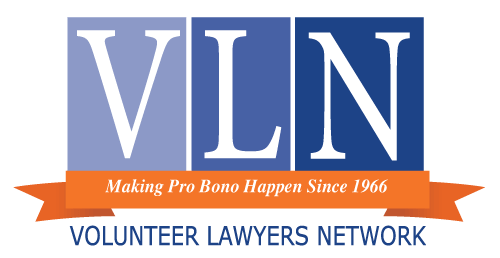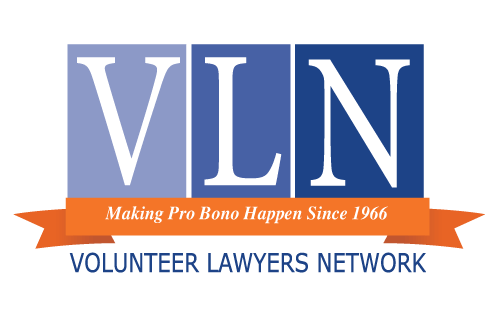Volunteer Resources
Resources for Programs
VLN provides many skill-based and legal resources to support your high-quality services to your VLN clients. Agency-wide resources are provided below.
General Resources for Volunteering:
- Volunteer Handbook
- New Volunteer Orientation Video
- Upcoming CLEs. Our CLEs include trainings on substantive law issues common to people living in poverty both generally and in specific areas of law.
Additional Trainings:
- Helping Clients in Poverty Overcome Barriers to Equal Justice: This essential three-page summary includes the most important concepts from the 4.0-hour Breaking Poverty Barriers to Equal Justice curriculum, based on the work of Dr. Donna Beegle. For the additional impact of race, see The Impact of Race in Pro Bono Services.
- Guide for Working with Gender Diverse Clients: This document goes over the challenges LGBTQ+ people may face in daily life, how these challenges can affect gender diverse clients when seeking legal services, and tips for volunteers on how best to support gender diverse clients.
Forms for VLN Cases:
Interpreting Services
VLN also provides interpreting services for telephone and face-to-face meetings at no cost to volunteers or clients. Click here to see the procedure for requesting an interpreter, and please review these guidelines for using our telephone interpreters.
If you need help beyond these, please contact the case placement coordinator or resource attorney in the area where you are volunteering.
Credit for Pro Bono (including Mentoring)
Attorneys volunteering through VLN may report one CLE credit for every six hours of pro bono work through VLN. This includes, for example, volunteering on full representation cases, at clinics, and/or to mentor another VLN volunteer. For every three-year reporting cycle, attorneys volunteering through VLN can claim up to six credits this way. For more information, see CLE Credit for Pro Bono.
Malpractice Insurance Information
VLN provides malpractice insurance for all pro bono representations undertaken through VLN. To qualify for VLN’s malpractice insurance, an attorney must have completed a registration form, been approved for volunteering, and have a client obtained through VLN. Obtained through VLN includes clients seen at VLN clinics or referred to the attorney as a VLN client by a VLN staff person. If you receive a malpractice complaint, an ethics complaint, notice of an ethics investigation, or think you may need to utilize VLN’s malpractice insurance, please contact VLN’s Executive Director, Tom Walsh by email at tom.walsh@vlnmn.org or at (612) 752-6675 as soon as possible.
Retiring Attorneys
Retiring or retired attorneys (62+ years old) with emeritus status may provide pro bono legal representations to VLN pro bono clients without having to pay the annual registration fee necessary for an active license to practice law. See Become an Emeritus Pro Bono Attorney through VLN and the Affidavit of Emeritus Status.
LawHelpMN.org
LawHelpMN.org provides answers to legal questions, contact information for legal aid offices, and links to courthouses and local community organizations. The site features fact sheets written for low-income clients about poverty law issues. These handouts can help explain legal issues to clients or be used as a starting point to educate attorneys on new legal topics.
ProJusticeMN.org
ProJusticeMN.org provides sample pleadings, online document assembly tools, and recorded training sessions on a wide variety of poverty law issues. VLN highly encourages all of our volunteers to register with and use ProJusticeMN.org. Access to the website is free, but registration is required.
Hennepin County Bar Association
The Volunteer Lawyers Network (VLN) is the pro bono arm of the Hennepin County Bar Association. For decades, the HCBA has had a unique partnership with VLN, providing core funding and promoting VLN as HCBA members’ primary resource for connecting with opportunities to fulfill pro bono obligations. More information about the benefits of bar membership and how to join can be found here online.
Stay connected and informed by subscribing to our Monthly Message! Our newsletter delivers a monthly roundup of information featuring updates on events and campaigns, clinic changes, new developments within VLN, and exciting volunteer opportunities. Get a firsthand look at the latest happenings and ways you can make a meaningful impact!
Tip of the Month
Since April 2006, Volunteer Lawyers Network has published a monthly short summary of an often-new area of law that we call the Tip of the Month. Want to access Tips from our archive? Email the Development and Events Manager!
April 2024 – How to Vacate Default Judgements in Conciliation Court
March 2024 – MN Cannabis Law & Immigration
February 2024 – Minnesota’s New Extreme Risk Protection Order Law
January 2024 – Eviction Expungement Changes
December 2023 – Minnesota’s New Law on Coerced Debt for Victims of Domestic Abuse, Harassment, and Trafficking
November 2023 – Manufactured Home Park Evictions
October 2023 – Driver’s License for All: Ready, Set, Go!
September 2023 – Golden Years: The Rewards of Volunteering
August 2023 – Updates on Expungement Law: Cannabis and Other Offenses
July 2023 – The New 504B Statute: What Every Lawyer Should Know About the Recent Legislative Changes to Landlord/Tenant Law in Minnesota
June 2023 – What to Do When Clients Stop Responding
May 2023 – How the Disposition of a Case Affects the Burden and Petition in Criminal Expungement Cases

